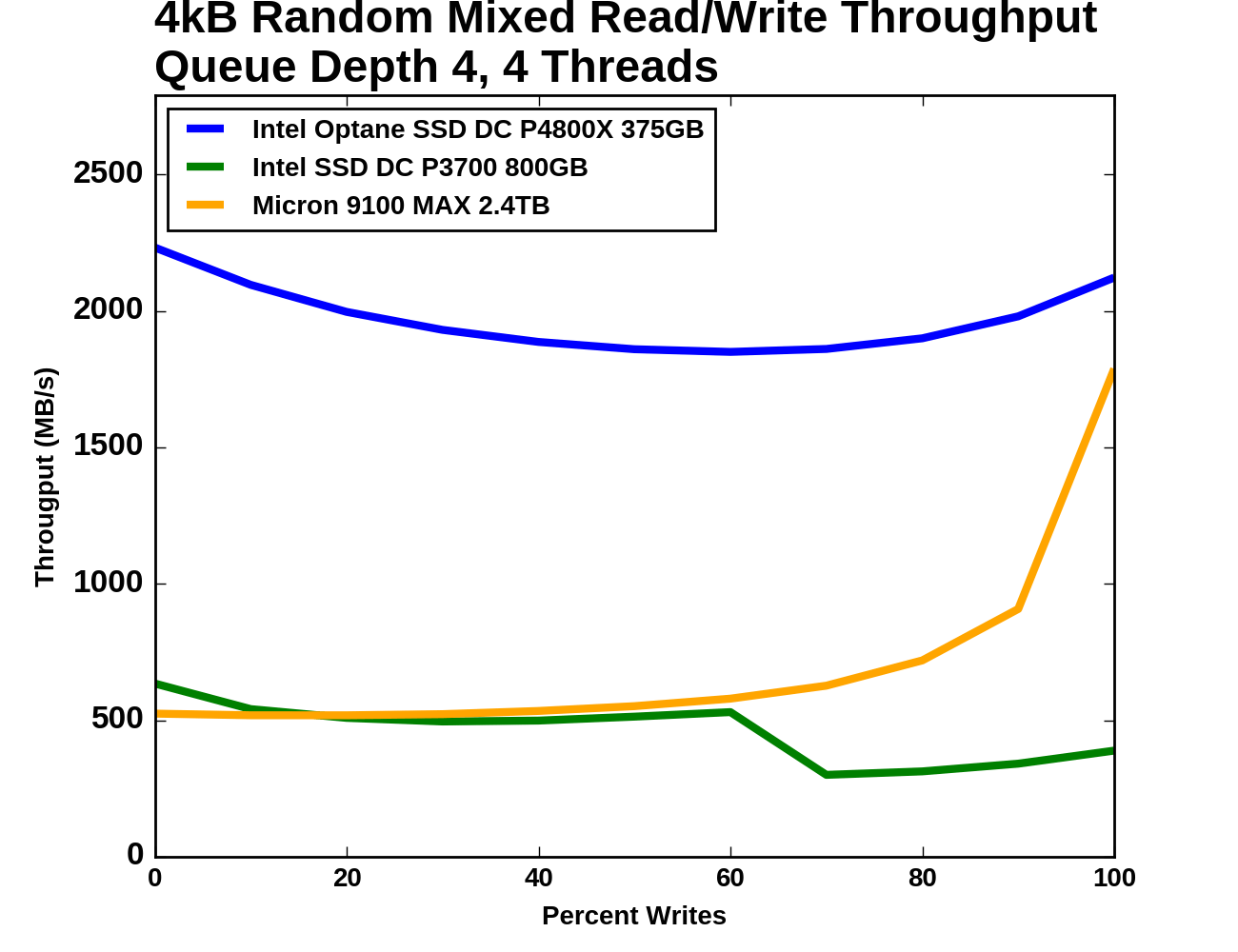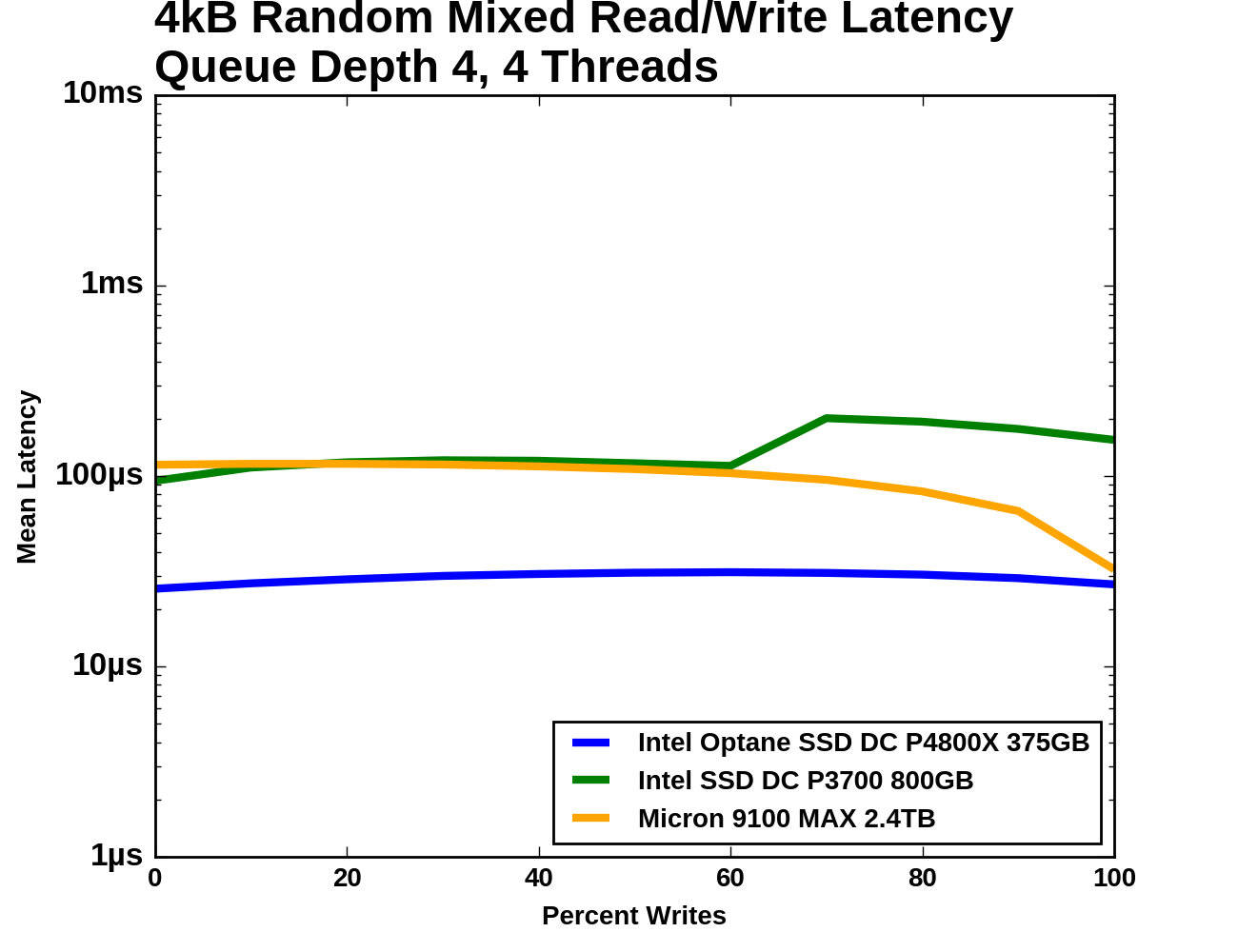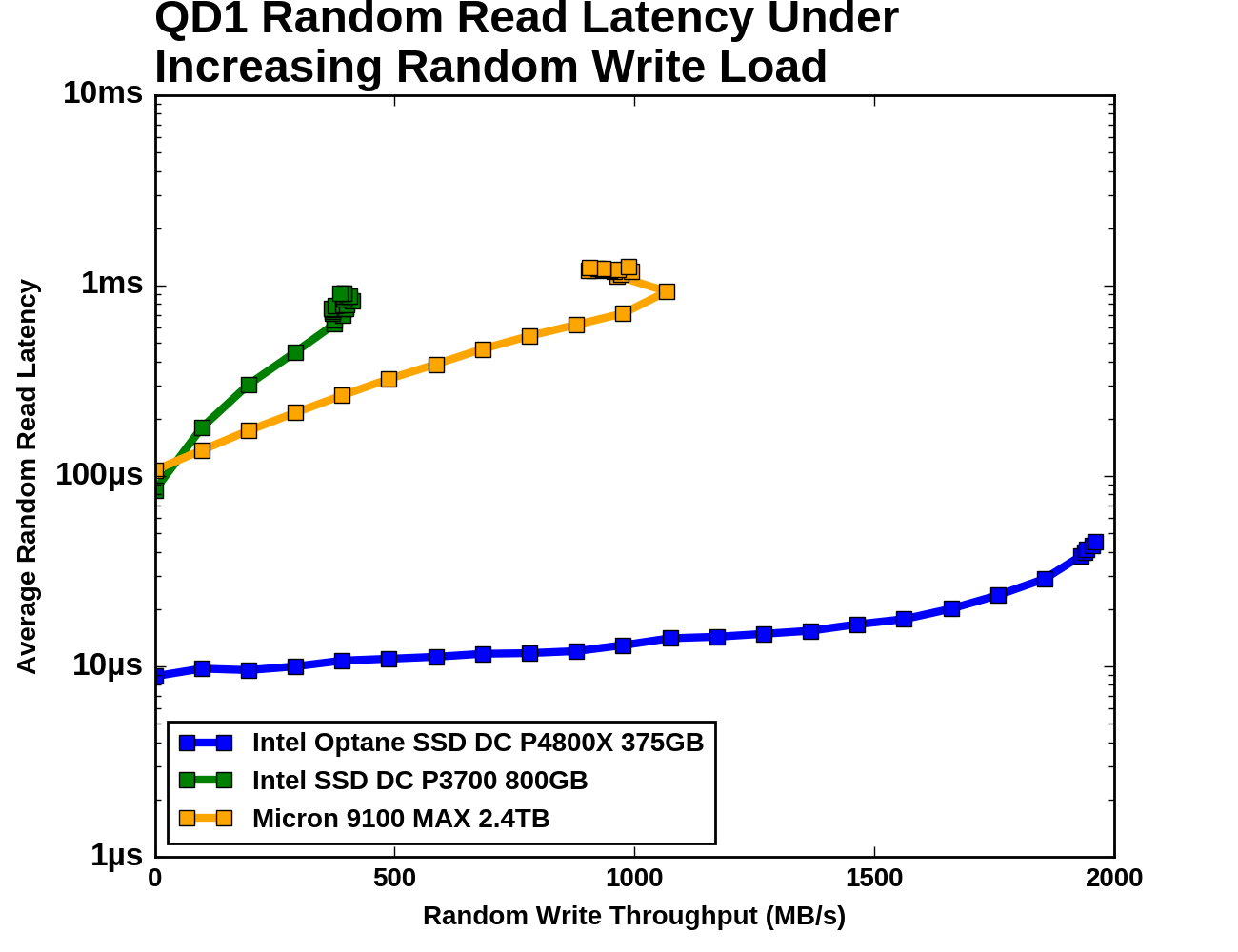The Intel Optane SSD DC P4800X (375GB) Review: Testing 3D XPoint Performance
by Billy Tallis on April 20, 2017 12:00 PM ESTMixed Read/Write Performance
Workloads consisting of a mix of reads and writes can be particularly challenging for flash based SSDs. When a write operation interrupts a string of reads, it will block access to at least one flash chip for a period of time that is substantially longer than a read operation takes. This hurts the latency of any read operations that were waiting on that chip, and with enough write operations throughput can be severely impacted. If the write command triggers an erase operation on one or more flash chips, the traffic jam is many times worse.
The occasional read interrupting a string of write commands doesn't necessarily cause much of a backlog, because writes are usually buffered by the controller anyways. But depending on how much unwritten data the controller is willing to buffer and for how long, a burst of reads could force the drive to begin flushing outstanding writes before they've all been coalesced into optimal sized writes.
The effect of a read still applies to the Optane SSD's 3D XPoint memory, but with greatly reduced severity. Whether a block of reads coming in has an effect depends on how the Optane SSD's controller manages the 3D XPoint memory.
Queue Depth 4
Our first mixed workload test is an extension of what Intel describes in their specifications for throughput of mixed workloads. A total queue depth of 16 is achieved using four worker threads, each performing a mix of random reads and random writes. Instead of just testing a 70% read mixture, the full range from pure reads to pure writes is tested at 10% increments.
 |
|||||||||
| Vertical Axis units: | IOPS | MB/s | |||||||
The Optane SSD's throughput does indeed show the bathtub curve shape that is common for this sort of mixed workload test, but the sides are quite shallow and the minimum (at 40% reads/60% writes) is still 83% of the peak throughput (which occurs with the all-reads workload). While the Optane SSD is operating near 2GB/s the flash SSDs spend most of the test only slightly above 500MB/s. When the portion of writes increases to 70%, the two flash SSDs begin to diverge: the Intel P3700 loses almost half its throughput and only recovers a little of it during the remainder of the test, while the Micron 9100 begins to accelerate and comes much closer to the Optane SSD's level of performance.
 |
|||||||||
| Mean | Median | 99th Percentile | 99.999th Percentile | ||||||
The median latency curves for the two flash SSDs show a substantial drop when the median operation switches from a read to a cacheable write. The P3700's median latency even briefly drops below that of the Optane SSD, but then the Optane SSD is handling several times the throughput. The 99th and 99.999th percentile latencies for the Optane SSD are relatively flat after jumping a bit when writes are first introduced to the mix. The flash SSDs have far higher 99th and 99.999th percentile latencies through the middle of the test, but much fewer outliers during the pure read and pure write phases.
Adding Writes to a Drive that is Reading
The next mixed workload test takes a different approach and is loosely based on the Aerospike Certification Tool. The read workload is constant throughout the test: a single thread performing 4kB random reads at QD1. Threads performing 4kB random writes at QD1 and throttled to 100MB/s are added to the mix until the drive's throughput is saturated. As the write workload gets heavier, the random read throughput will drop and the read latency will increase.
The three SSDs have very different capacity for random write throughput: the Intel P3700 tops out around 400MB/s, the Micron 9100 can sustain 1GB/s, and the Intel Optane SSD DC P4800X can sustain almost 2GB/s. The Optane SSD's average read latency increases by a factor of 5, but that still enough to provide about 25k read IOPS. The flash SSDs both experience read latency growing by an order of magnitude as write throughput approaches saturation. Even though the Intel P3700 has a much lower capacity for random writes, it provides slightly lower random read latency at its saturation point than the Micron 9100. When comparing the two flash SSDs with the same write load, the Micron 9100 provides far more random read throughput.











117 Comments
View All Comments
ddriver - Sunday, April 23, 2017 - link
It is not expensive because it is new, it is expensive because intel and micron wasted a crapload of money on RDing it and it turned out to be mediocre - significantly weaker than good old and almost forgotten SLC. So now they hype and lie about it and sell it significantly overpriced in hopes they will see some returns of the investment.Also, it seems like you are quite ignorant, ignorant enough to not know what "order of magnitude" means. You just heard someone smart using it and decided to imitate, following some brilliant logic that it will make you look smart. Well, it doesn't. It does exactly the opposite. Now either stop using it, or at the very least, look it up, understand and remember what it actually means, so the next time you use it, you don't end up embarrassing yourself.
factual - Sunday, April 23, 2017 - link
"significantly weaker than good old and almost forgotten SLC"Seriously ?! You must be getting paid to spew this bs! no one can be this ignorant!! can you read numbers ?! what part of 8.9us latency don't you understand, this is at least 10x better than the latest and greatest NVMe SSDs (be it TLC, VNAND or whatever bs marketing terms they feed idiots like you nowadays).
what part of 95K/108K QD1 IOPS don't you understand ?! This is 3-10x compared to this best SSDs on the market.
So I repeat again, Xpoint is orders of magnitude better performing than the latest and greatest SSDs (from Samsung or whichever company) on the market. This is a fact.
You don't even understand basic math, stop embarrassing yourself by posting these idiotic comments!
ddriver - Monday, April 24, 2017 - link
LOL, your intellect is apparently equal to that of a parrot.factual - Monday, April 24, 2017 - link
Well if this fruitless exchange is any evidence my intellect is far superior to yours. So If my intellect is equal to that of a parrot, yours must be equal to that of a maggot ... lolevilpaul666 - Saturday, April 22, 2017 - link
So where are the 32gb client ones?tomatus89 - Saturday, April 22, 2017 - link
Who is this ddriver troll? Hahaha you are hillarious. And the worse is that people keep feeding him instead of ignoring him.peevee - Saturday, May 27, 2017 - link
From your testing, looks like the drive offers real advantages on low QD, i.e. for desktop/small office server use. For these uses a normal SSD is also enough though.Given that modern Xeons have up to 28 cores (running 56 threads each) and server motherboards have 2 or more CPU slots, a properly loaded server will offer QD > 64 all day long, and certainly not just 4 active threads - where the Micron 9100 offers even higher performance, and if the performance is good enough there, it certainly good enough on lower QDs where it is even better PER REQUEST.
And who cares what 99.999% latency is, as long as it is milliseconds and not seconds - network and other latencies on the accesses to these servers will be higher anyway.
An incredibly good first attempt, but it really does not push the envelope in the market it is priced for - high-performance storage-bottlenecked servers.